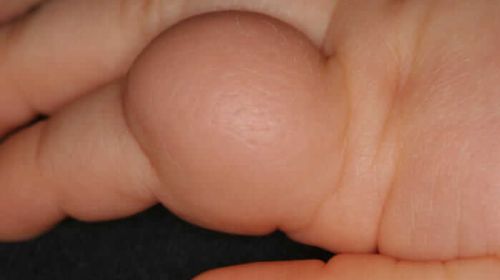Lipomas are benign tumors made up of fat cells. They form just under the skin and appear as small, soft lumps or bumps. Although they are harmless, they can be perceived as annoying. How a lipoma forms and when it can be removed.
- © cristianstorto – stock.adobe.com
Quick overview: Frequently asked questions and answers
Why do you get a lipoma? The exact cause of lipoma formation is not known, but genetic factors and possibly injury to subcutaneous fat are believed to play a role.
Should you have a lipoma removed? Lipoma removal is usually only recommended if the tumors cause pain, grow quickly, or are perceived as disturbing for aesthetic reasons.
What can you do about a lipoma? Treatment can range from observation without intervention to surgical lipoma removal under anesthesia.
How do you tell if a lipoma is cancerous? A lipoma is generally considered benign. Signs of possible malignancy can include rapid growth, pain and a firm consistency, which is why a medical examination is important for an accurate diagnosis.
Article contents at a glance:
What is a lipoma?
A lipoma is a benign soft tissue tumor made up of fatty tissue that grows slowly under the skin. These tumors form when fat cells multiply and a capsule of connective tissue forms around the lipoma. A lipoma is usually clearly visible from the outside as a swelling.
Lipomas are particularly found in areas with a lot of subcutaneous fat, such as:
- neck
- shoulder
- Upper arms
- Thigh
- Back
- Belly
As a rule, lipomas are painless and do not pose a serious health risk. An exception is the painful angiolipoma. In addition to fat cells, this special form also contains small blood vessels. Rarely, muscular lipomas form beneath muscles.
Benign soft tissue tumors of the skin
Benign tumors in connective tissue and fatty tissue include these three forms:
- Lipoma from fatty tissue
- Fibroma arises from connective tissue
- Atheroma in the subcutaneous tissue made of sebum and skin cells (cyst)
Lipoma symptoms
The spectrum ranges from small, mobile and elastic nodules that measure only a few millimeters to so-called giant lipomas that can grow up to 20 centimeters in size. While large bumps only occur in rare cases, one to two percent of the population have smaller lipomas.
Depending on their location and size, the growths can put pressure on nerves and blood vessels. As a result, it can
- Tingle,
- numbness and
- Pressure pain occurs.
Lipomas that form in areas subject to mechanical stress, such as near joints, can also cause problems. In addition, they are sometimes perceived as unsightly for aesthetic reasons.
Removing lipoma: what methods are there?
Although lipomas are generally harmless, some people choose to have them removed for cosmetic reasons. Treatment should be considered, especially if a lipoma causes symptoms.
In principle, two methods are available:
surgical removal: The operation is usually carried out under local anesthesia with a small incision through which the lipoma is removed. For larger lipomas, patients may require general anesthesia. Lipoma removal is considered safe and has few complications.
Liposuction (liposuction): A method from aesthetic medicine in which a special solution is injected into the lipoma via syringe to liquefy the fatty tissue. The tissue can then be suctioned off. However, there is a risk that not the entire lipoma will be removed.
Both methods offer effective solutions for removing lipomas, with the choice of method depending on the size, location and individual needs of the patient.
Good to know: Sufferers should not attempt to remove a lipoma themselves as this can lead to serious complications. These include infections and bleeding. In addition, incomplete lipoma removal can promote the growth of the fatty tumor.
Prognosis after removal
There is a possibility that lipomas may recur after removal. A second intervention is often necessary. However, only in rare cases does a lipoma develop into a malignant tumor.
Causes of a lipoma
The exact cause of lipoma formation has not yet been clarified. However, a genetic predisposition appears to play a role, particularly when many lipomas occur at the same time (lipomatosis). People with a family history of lipomas are at increased risk of developing them as well.
Injuries to certain parts of the body can also promote the formation of the growths.
It has not yet been conclusively clarified whether there is a connection with diabetes mellitus or other metabolic diseases. There is also evidence of a link with alcohol abuse. It is also suspected that high blood lipid levels can promote the formation of a lipoma.
Diagnosis when a lipoma is suspected
It is advisable to have any lipoma examined by a doctor to distinguish it from other growths such as cysts. For diagnosis, the doctor inspects the swelling under the skin and feels it. In addition, imaging procedures such as ultrasound (sonography) or X-rays can be used to precisely identify the lipoma.
The removal of tissue (biopsy), which is examined under the microscope, is used to rule out a malignant tumor.
Liposarcoma: Can a lipoma become cancerous?
In contrast to lipomas, liposarcomas are malignant fatty tissue tumors. They can occur in any part of the body, but are more commonly found in the legs, especially the thigh area, and the abdomen.
Liposarcomas differ from lipomas in their ability to
- to grow quickly,
- penetrate into surrounding tissue and
- To form metastases in other parts of the body.
The exact cause of liposarcomas is not fully understood, but genetic changes within cells play a role in their development. Early diagnosis and treatment are crucial for the prognosis of liposarcomas.


